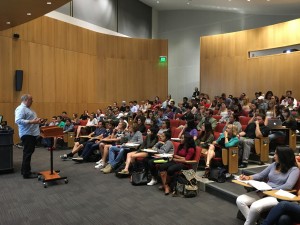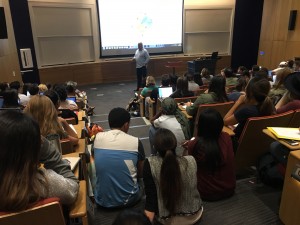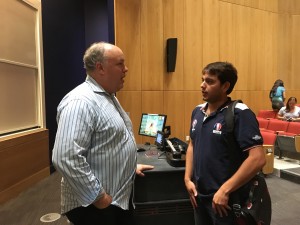Communications Media Is Constantly Evolving And Creating New Methods
On Oct. 20, the Department of Marketing and Entrepreneurship at St. Edward’s University hosted Bob Pearson, president of W2O Group, for the Distinguished Marketer Speaker Series. The event drew a crowd of students interested in hearing speaker Bob Pearson’s perspective on the evolving nature of communications and media. Pearson began the event explaining that what he was going teach students that night were lessons he was still learning himself. The way media is communicating with audiences is always changing, he said. Traditional methods of advertising to customers are out-of-date.
Pearson explained that traditional market segmentation is not working anymore. Rather, micro-segmentation is necessary to reach the right audience. For example, he said, reaching out to the right five people for your product or service, instead of 5,000 people, is a more successful tactic because those five people will share your message with others looking for the same solution.
Getting Meaningful Media Across To Your Audience
Shared, earned and owned media (POEM) has more impact than paid media alone, Pearson said. Earned or shared media, such as Facebook or LinkedIn, provides the best way to reach customers because they are already on those platforms. Pearson argued that email was never the right model for conversion. 99% of customers will see the email, ignore or delete, he said. Instead of reeling customers in for a sale, emails drive them away. Although email is a great tool for retention, many companies have had poor experiences using emails to attract customers. The rate of .5% vs 5-15% conversion rate of prospecting emails is not effective.
Marketing campaigns can be slow and miss trends. For an audience, there are at least 42 people that can heavily influence the conversation. They can reach out to the audience in a way that can make the rest of the world move within the conversation and make the news spread. Repacking the news, moving the conversation, and seeing everything online from the audience. Online is where brands can communicate with the audience and see what they need, which is essential for a campaign. Online is where marketers can see the behavior of the audience and how to move the news that needs to be communicated. Pearson said that “customers like to see three things online more any others: ideas, knowledge, and solutions”. The media landscape has completely changed. The things online hat drive attention, news, and conversation are blogs, Twitter, Facebook, and and video, more than mainstream media. All forms media are much more visual and attractive.
The Fundamentals Of Media Efficiency
Pearson explained that there were five fundamentals of media efficiency: listening, influencers, language, content, and distribution. Listening is insights driven by publishing platforms that can be on any device. Influencers are people telling the story. It is important to get the right people to tell the story. Pearson said that for every top 50 people within an audience, there are 4 top influencers. Regarding language, there are top 15 keywords that optimize search. The content is what drives the message and gets the attention of the audience. It is important to engage the audience within 3 to 7 seconds, or else they are clicking to the next thing. Distribution is where they are receiving the information.
Tips On How To Drive Your Content Media
According to Pearson, marketers need to have a coverage plus model. Sharing coverage with an audience is done via shared media (which is earned and strategically paid media). Another trend is that people are reading less than ever and seeing more visual media (television, videos, images, etc). Pearson gave a 1, 9, 90 model for earned and shared media: 1% of the audience create the content (influencers), 9% of the audience actually share and repackage the media (advocates), and 90% will just listen and learn the media (enthusiasts). A marketer must use paid media strategically and build content knowing there are only three seconds to get a customer’s attention. Rethinking how to promote the firm’s website, videos, media, and how you talk to your public/talk in public. Another important point is knowing which people and outlet drive the search position you care about because your reputation is being formed with or without you. If you form it, you have control in how it is portrayed. If you do not, then the media that it around you will portray you for you.
For more of Bob Pearson’s findings and teachings of communications media, check out his book “Storytizing”.




